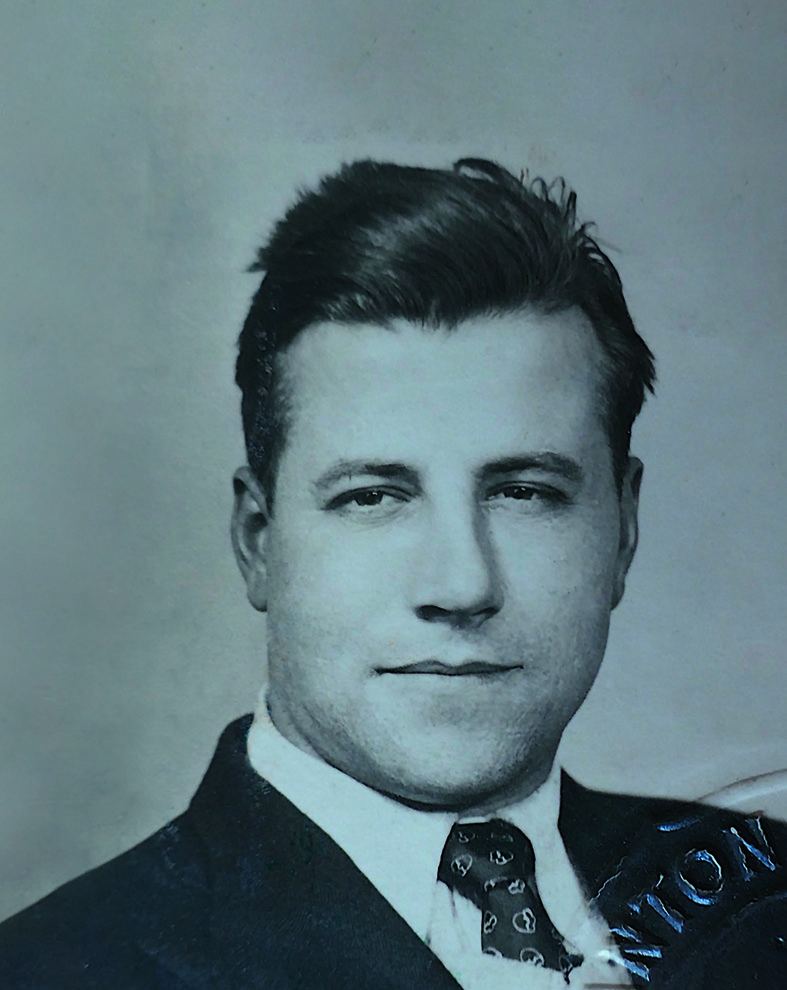
Alfred Gasser (passport photo dated 12/12/1951).
Archive of M. Gonzalez Gasser. Photo: M. Maggetti.
Marino Maggetti, 2021
Most people are familiar with Langenthal porcelain and the company Rössler in Matzendorf – but a porcelain manufactory in the middle of the Canton of Fribourg? One such manufactory did in fact exist from 1954 to 19611.
Alfred Henri Gasser (1918–20112) was the second child of Ernst Gasser (1887–1972) and Emma, née Gonet (1889–1978). Ernst Gasser came from a long line of tile makers from Rüschegg (Canton of Bern) and was managing engineer of the tile yard and briquette factory in Lentigny from 1918 until it closed its doors in 19313. By that time, the deposits, from which the clay had been extracted since 1865 or 1869, were exhausted. Ernst Gasser built a new factory in Corbières, transferred the machines to the new plant and resumed production in 1932.
We know very little about Alfred Gasser’s career, as the company archive was destroyed along with everything else (machines, products, etc.) when his factory went up in flames in 1962. According to family lore, however, he got a diploma from the Swiss School of Ceramics in Chavannes-près-Renens (Canton of Vaud). During the Second World War he amassed a small fortune by exploiting the peat bog at Lentigny, which he had purchased in 1941. During the war, turf was used instead of coal from abroad to heat houses and run gas-powered vehicles. In 19454, he used this money to set up a pottery manufactory in the vast premises of the former tile yard and briquette factory in Lentigny and called it “Industrie de céramique fine” (ICF)5.
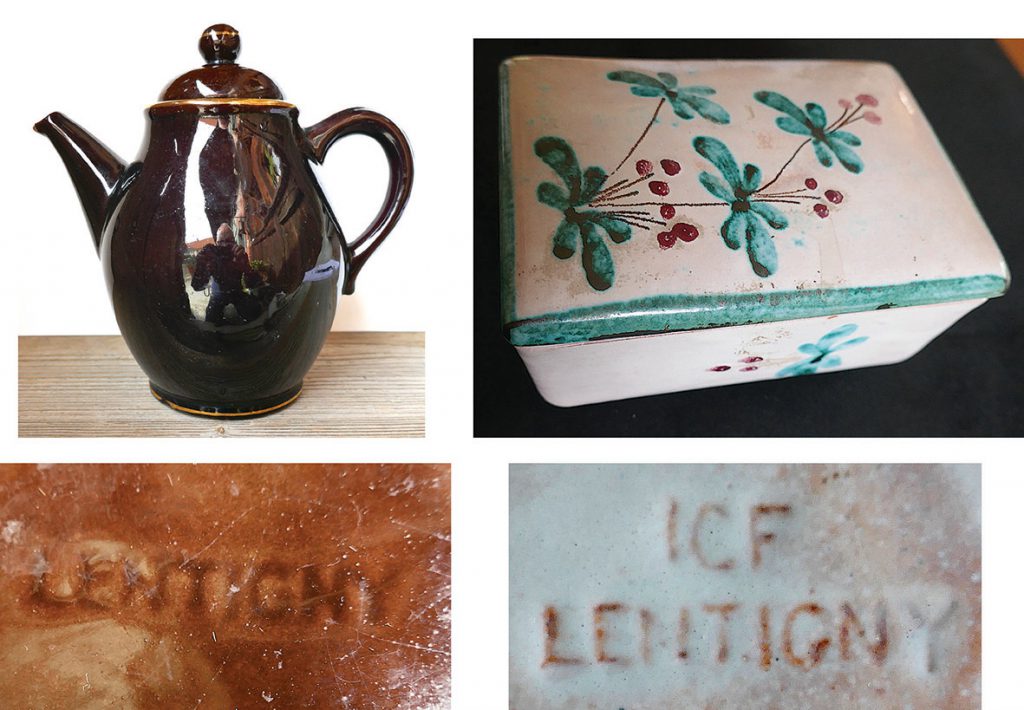
Fig. 1 Examples from the range of products made by Alfred Gasser between 1945 and 1953: coffeepot, earthenware, brown slip both inside and out, transparent lead glaze. Impressed mark LENTIGNY. Height 16 cm. In private ownership; faience box, painted decoration. Impressed mark ICF LENTIGNY. 12.7 x 8.7 x 6.7 cm. From a private collection. Photos: M. Maggetti.
Gasser produced earthenware, faience6 and even industrial pottery7. The clay was delivered by truck from the Hauteville region8. The range included both everyday wares (boxes, coffeepots, ashtrays for advertising purposes, jugs for distilleries, liqueur bottles, round and square platters, milk jugs, cups, flower vases) and studio pottery (Fig. 1). The fabric was brick red. The earthenware was often coated in a whitish slip, and the lead-based transparent glazes were brown in colour. A small group of objects had decorations painted in black, and many had fine decorations in gold. The faience vessels had air-brushed (using opaque monochrome glaze in blue, green or purple) or very simple painted decorations, mainly in the form of green and red floral motifs (Fig. 1). Underglaze impressed marks LENTIGNY or ICF LENTIGNY are rarely found.
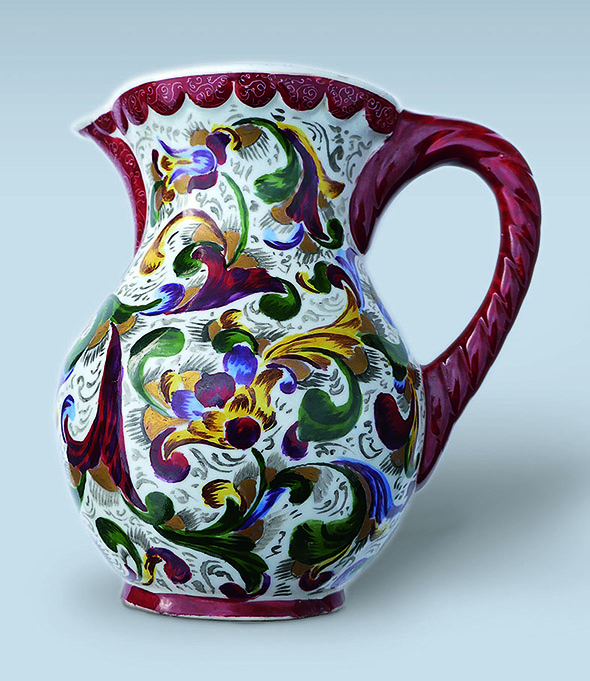
Fig. 2 Porcelain by Alfred Gasser (1954–1961). Jug, polychrome decoration. Underglaze stamped mark LENTIGNY SWITZERLAND 55. Height 16.6 cm. From a private collection. Photo M. Maggetti.
In 1953 and 19549, Alfred Gasser converted his company to a porcelain manufactory, the only one in the French-speaking part of Switzerland. This was done for economic reasons, as this type of pottery was, at the time, very much in vogue; it was also more hygienic and more impact-resistant than traditional pottery. The fact that porcelain was more expensive was no longer an issue, as by the 1950s, the majority of people in Switzerland could afford such luxury wares. Alfred also spotted an opportunity to supply the electrical industry (switches, fuses, isolators), laboratories (laboratory porcelain) and other fields of industrial manufacture. Experts from Germany installed a kiln 30 metres long, and it was German workers who helped him to get the production up and running. These and other workers were housed in eleven rooms on the upper floor of the factory building. The workforce also included Alfred’s four children who were constantly urged by their father to help out in the business. The material used in the manufacture was the same classic hard-paste porcelain that was produced in Langenthal: 50 percent Czech kaolin, 25 percent white sand and 25 percent potash feldspar. The range of products included a vast selection of objects10: baby plates, prize plates, commemorative pieces, bonbonnières, ashtrays, eggcups, cream jugs for restaurants, jugs, schnapps bottles, small jugs, armorial dishes, fish platters, milk jugs (1, 1.5 and 2 litre sizes), saltshakers, cups and vases (Figs. 2–4).

Fig. 3 Porcelain made by Alfred Gasser (1954–1961). A saltshaker, an eggcup with gold decoration and a cream jug for a restaurant, various kinds of small vases. Stamped marks LENTIGNY or LENTIGNY SWITZERLAND. Height of the cream jug 5.5 cm. From a private collection. Photo M. Maggetti
Prominent Fribourg businesses like the Villars chocolate factory placed large orders for the Christmas season. Others came from the sports, economic and arts associations throughout the canton. The manufactory’s products were distributed either by regional businesses or by salespeople travelling from village to village.11 As early as 1955, the “Manufacture de porcelaine, Lentigny” was presenting its wares at the 39th Mustermesse fair in Basel12. According to his children, Alfred Gasser increasingly experienced financial difficulties. Also, the other two Swiss porcelain factories cannot have been too happy about having yet another rival in the French-speaking part of the country. Rumour had it that Langenthal even sent workers to Lentigny to sabotage the company. In 196113, production ceased. Some of the premises were subsequently used to rear chicks and fatten calves14. On 12th August 1962, the factory was destroyed by fire15. The premises were rebuilt and in the 1970s, a prominent tenant moved in: the Fribourg racing driver Jo Siffert used them to house his cars and to test his engines16. His mechanic André Marti set up a garage in the premises next door.
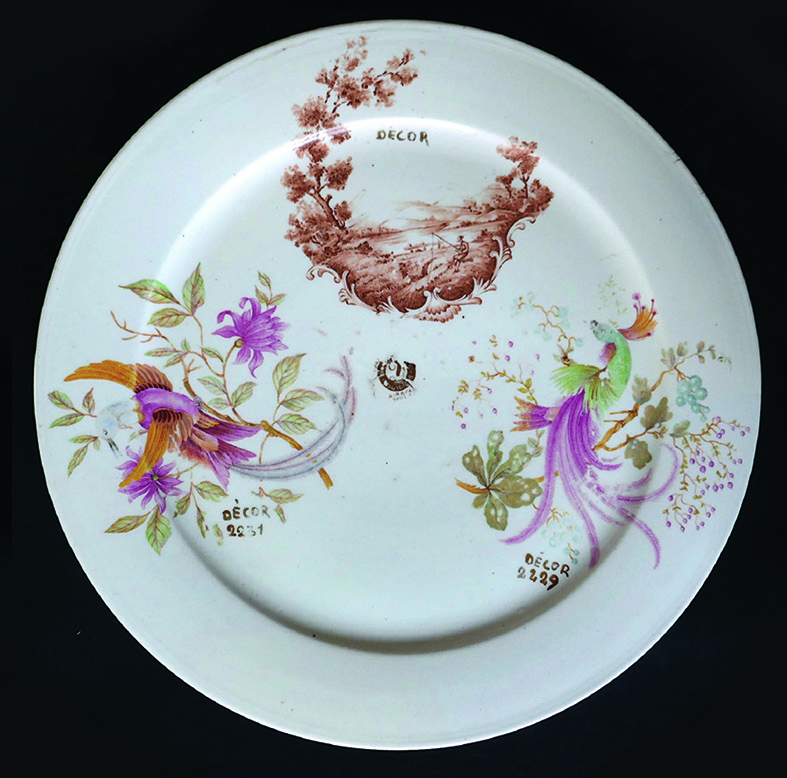
Fig. 4 Porcelain made by Alfred Gasser (1954–1961). Plate with samples of overglaze decoration (polychrome and monochrome bistre, central black medallion difficult to decipher). Underglaze stamped mark LENTIGNY SWITZERLAND 55. Diameter 19.8 cm. Private collection. Photo M. Maggetti.
The designs used were varied. Transparent, colourless or blue glazes, mirror glazes in a variety of colours, underglaze decorations, floral overglaze lithographic printed decoration and fine gold decorations. Almost all objects had stamped marks. They were applied in chrome green pigment to the backs of the biscuit-fired vessels and then covered over by the glaze.
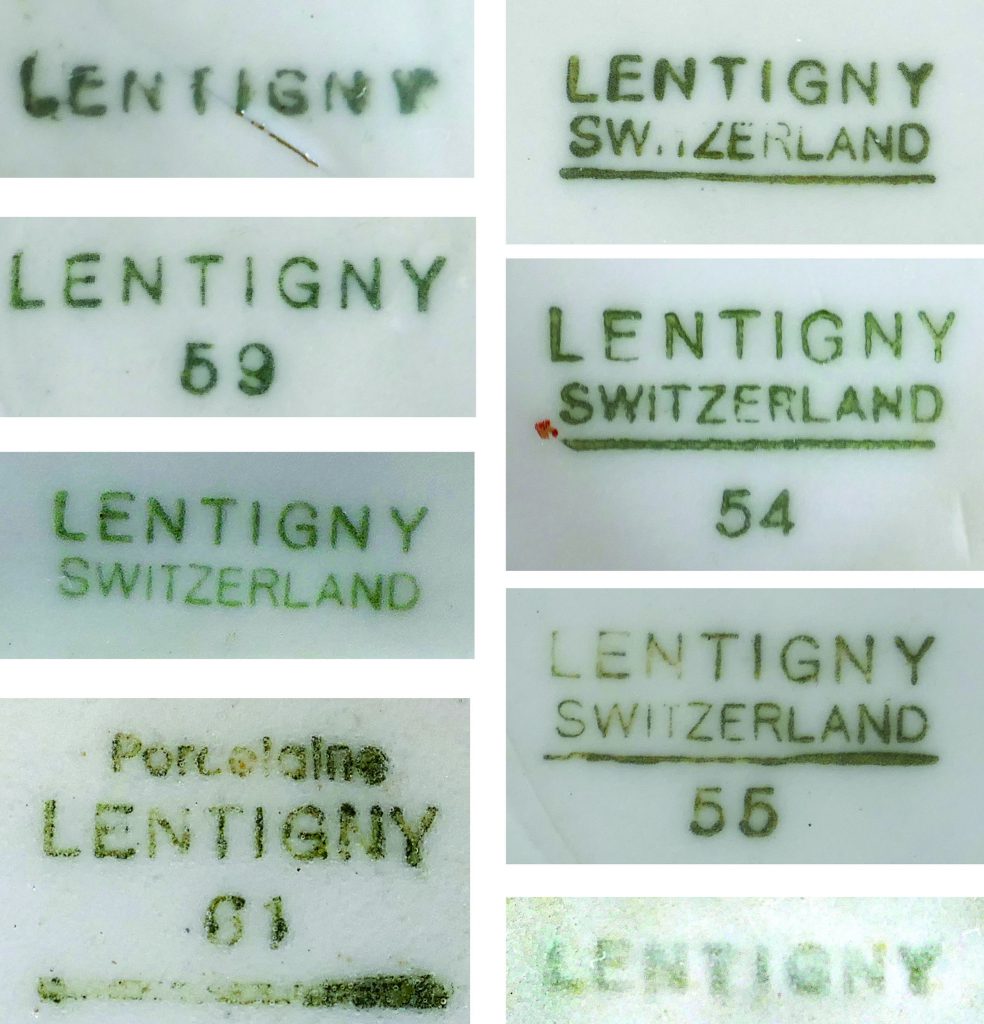
Fig. 5 The marks found on Lentigny porcelain so far. Seven were stamped, one (bottom right) was impressed. Photos M. Maggetti.
Bearing in mind the rather short production period, the variety of marks is remarkable: LENTIGNY, LENTIGNY 59, LENTIGNY SWITZERLAND (with or without a horizontal line beneath SWITZERLAND), LENTIGNY SWITZERLAND 54, LENTIGNY SWITZERLAND 55 and Porcelaine LENTIGNY 61 (Fig. 5). Only one object had an impressed mark LENTIGNY.
Unfortunately, Alfred Gasser’s work has been forgotten. None of his objects found their way into any of the Swiss museum collections, nor does the CERAMICA CH database include any examples. This short paper is intended to make the members of our society curious and draw collectors’ attention to this little-known Fribourg potter. I would like to compile a catalogue of Alfred Gasser’s works, and I would be grateful for any information about any of his ceramics17.
My heartfelt thanks to Alfred Gasser’s sister, Nelly Anna Tschanz Gasser, his two daughters, Madeleine Gonzalez Gasser and Elisabeth Boscacci Gasser, and his niece, Claudine Buchs Gasser, for the warm welcome I received during this pandemic; I am grateful for the invaluable information they have given me about the life and ceramic work of their relative. I would also like to thank Patrick Dietsche for his bibliographic research, Roland Blaettler for his critical editing of the text and Daniel Diezi for the care and attention that went into the layout.
Online publication by courtesy of Keramikfreunde der Schweiz, 2021.
Footnotes:
- Rolle 2006. The paper by Kim de Gottrau “Tuiles, porcelaines … et même poulets” (La Liberté, 21st August 2019), is a useful source of information about Alfred Gasser’s tile yard and pottery businesses.
- Based on personal communication from Alfred Gasser’s children on 17th September 2020, Maggetti/Galetti 2020, 68, quote his date of death as 2014. Since then, our research has unearthed an obituary published in La Liberté on 14th October 2011, according to which Alfred Gasser died on Friday 14th October 2011, at the age of 94.
- The tile yard was named after the nearby village of Lentigny, even though it was actually located within the municipality of Autigny.
- A badge that Alfred Gasser had engraved and mounted on one of the machines provides a date for the beginning of his ceramic activities in Lentigny: “Paste kneader/for the production of hard-paste porcelain (1420 °C)/in use from 1953 to 1961/left over from the pottery factory here in Lentigny/1945–1961.” The kneader is now in the garden of the house where the Gasser family lived.
- La Liberté, 9th October 1953: “The Pottery Factory at Lentigny” (signed by E. M.): “The Industrie de céramique fine (ICF) […] was set up […] in these spacious premises.” According to the article, the manufactory was set up in c. 1948, though this is not correct (see footnote 4). The name of the manufactory can also be found in advertisements. (La Liberté 23/5/1947, 21/7/1948, 24/9/1948).
- Just to remind readers: faience is earthenware covered with an opaque lead- and tin-based glaze.
- Advertisement in La Liberté, 23rd May 1947: “These isolators for electrical systems consist of an extremely hard material, have an unlimited life span and can withstand all types of weather. They are made and delivered by Industrie de céramique fine in Lentigny-Fribourg. Telephone 3.71.24. Special terms for traders.”
- This is probably the Le Rux deposit, which was exploited by the tile yard at Corbières under the management of Alfred’s father, Ernst (Maggetti/Galetti 2020, 69).
- La Liberté, 18th and 19th December 1954: “A Porcelain Manufactory in Lentigny” (signed by E. M.) tells us that Alfred Gasser began renovation work on his manufactory in 1953 and that the work took a year to complete. This means that porcelain production commenced in 1954, and not in 1953, as written on the badge on the kneader (see footnote 4).
- The article in La Liberté 26th October 1955: “A visit to the porcelain manufactory in Lentigny” (signed by E. M.) lists some of them.
- See footnote 1 (La Liberté).
- La Liberté, 18th April 1955: “In Basel. The 39th Swiss Mustermesse fair has opened its doors to the public” (signed by F. B.).
- La Liberté, 13th August 1862, “Major fire in Lentigny”; Freiburger Nachrichten, 13th August 1962, “Fire”; La Sentinelle, 13th August 1962, “Fire at former factory”.
- Footnotes 1 and 13.
- Footnote 13. The estimated damage was 250,000 Swiss francs. The Valais newspapers Le Nouvelliste (“Fire”) and Journal de Sierre et du Valais Central (under the heading “A few lines”) reported on the disaster on 13th August 1962 and on 14th August 1962 respectively.
- Footnote 1 (La Liberté).
- If possible with a photograph to the following email address: marino.maggetti@unifr.ch.
Translation: Sandy Haemmerle
References:
Marino Maggetti / Giulio Galetti (2020): Dachziegel der freiburgischen Ziegeleien Düdingen, Le Mouret und Corbières – chemische, geologische und historische Aspekte. In: Bulletin de la Société fribourgeoise des Sciences Naturelles, 109, 40-104.
Marino Maggetti (2021): Alfred Henri Gasser- manufactures de céramique fine (1945-1953) et de porcelaine (1954-1961) à Lentigny. Bulletin Keramikfreunde der Schweiz 97, 2021, 5-12.
Rolle, Marianne (2006): Lentigny. In: Dictionnaire historique de la Suisse.

